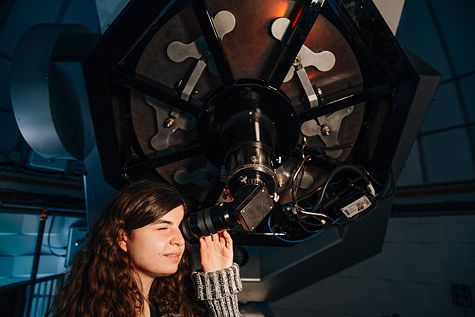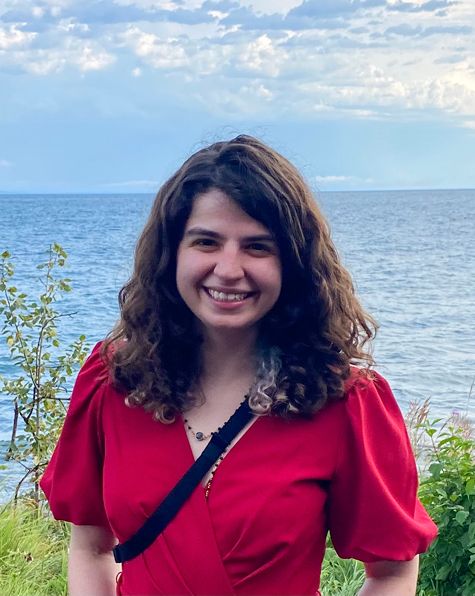Early Career Scientist Spotlight
Dr. Jenna Cann (she/they)
Astrophysicist
X-ray Astrophysics Laboratory (662)
What is your research focus?
I study black holes in dwarf galaxies. While we know there are supermassive black holes millions and billions of times the mass of our Sun found in the center of nearly all massive galaxies including in our own Milky Way, and we know there are stellar mass black holes (~10x the mass of our Sun) formed from the death of stars, there is currently no direct evidence for black holes with masses in between those extremes (~150 – 10,000x the mass of our Sun). This is a significant gap in our knowledge, because these “intermediate mass” black holes (IMBHs) can provide information about the mechanism(s) that formed the initial seeds our supermassive black holes grew out of. While we see many black holes formed from supernovae in the local Universe, recent high-redshift surveys of accreting black holes when the Universe was less than a billion years old have uncovered black hole masses of billions of times the mass of our Sun. This requires extremely rapid, sustained growth if the initial black hole seeds were to be remnants of early supernova, which is very unlikely but not impossible, so a detailed study of IMBHs is necessary to fill in the blanks and constrain the most likely formation pathway. These IMBHs are much more difficult to find than their higher mass counterparts, so there are many new methods of detection being tested out. One method that I work with often uses high-ionization emission lines, called coronal lines, in the infrared spectrum. This is a method that will be especially interesting with the launch of the James Webb Space Telescope (JWST), as we will have access to much more sensitive infrared spectra over a much wider wavelength coverage than ever before.
Did you always know that you wanted to be an astrophysicist?
Definitely not! I went through many different majors and career paths throughout high school and undergrad. When I was applying for colleges, I was looking into pursuing a Music Education or History major, and while I enjoyed the classes in both of those paths, I had a feeling that neither of them were truly what I wanted to do for a career. Since I wasn’t sure about my next steps, I decided to transfer from the College of William and Mary, where I had begun my undergrad, to the Northern Virginia Community College, and I took classes in Annandale, Virginia, for several years, as well as online courses about Music Business. I received my Associate of Science degree in Math and decided that I wanted to continue on that path, but that I wanted to use math to study something more concrete. From there, I picked Astronomy almost on a whim, transferred to George Mason University (GMU), and really found my place there. As I was finishing up my undergrad, one of my professors and a couple of grad student friends approached me about applying to grad school – I didn’t even think about the option until they brought it up, but I applied for a couple fellowships, and ended up continuing on as a National Science Foundation Fellow at GMU. As I worked on my PhD, I grew more and more confident about my place in this field, and decided I wanted to continue on to the next steps of a career in research!

Credit: Shobita Satyapal, George Mason University
Tell us about one project that has been particularly impactful in your field.
While I’ve been lucky to work on and lead several projects that have set the stage for some exciting science to be done with JWST, I’m most proud of my work with SPECTRUM, a Diversity, Equity, Inclusion, and Accessibility (DEIA) advocacy group at GMU. SPECTRUM started when several of my friends and I came together after being frustrated with the inequities that we were seeing in the department and spent a weekend writing a Code of Professional Conduct that was ultimately adopted by the faculty with no significant changes. The primary goals of this document were to visibly acknowledge the extra barriers that members of under-represented groups face in pursuing a STEM education and career, and to call on all members of the department to commit to actively dismantling those barriers, both at GMU and in the field as a whole. During our first meeting, we brainstormed several more initiatives that could further help support students from under-represented minorities at GMU. With our first win of the ratification the Code of Professional Conduct, we decided to keep going, which led to the founding of Spectrum! We worked with the department HR to create an incident report form, with an anonymous option, for anyone in the department to use if they felt the Code of Conduct was violated in any way, with several well-defined options for addressing concerns. We started a mentoring program that, in its first year, had ~30 members. We began weekly professional development lunch talks on both the “traditional” topics of career paths and skills as well as talks on anti-racism, mental health and wellness, and advocacy. We formed a faculty mentoring committee (of four faculty members and one staff member) to advocate for us in faculty-only spaces and meetings, and for us to be able to determine joint student-faculty solutions to issues in our department.
We did all of this in a pandemic, over many hours-long Zoom calls. While there’s still a long way to go in our field, it’s been very exciting to see the changes already occurring at GMU. Shout out to fellow SPECTRUM co-founders, Natasha Latouf, Carly Solis, and Kathryn Fernández!
How did you end up working at NASA Goddard?
In undergrad, I spent a year working on a project studying exoplanets with a GMU alum and friend, Dr. Prabal Saxena. It was a great experience and, while I ultimately decided exoplanet research wasn’t for me, I knew that Goddard seemed like a fun place to do research. While I didn’t do much work with Goddard throughout grad school, my partner was a postdoc there at the time, and I would come in to attend seminars. When I was exploring potential advisors and research groups at Goddard, I was put in contact with Dr. Kim Weaver, the X-ray Multi-Mirror (XMM-Newton) project scientist. We met virtually and really seemed to be a good match - she understood my passion for working on research while also continuing my DEIA and advocacy work, so the NASA Postdoctoral Program (NPP) quickly rose to being my top choice of postdoc positions. When I was awarded the NPP position, I immediately took it and celebrated!
What aspects of your work are you most passionate about?
I’m really passionate about studying objects and phenomena that are still very mysterious and unknown. Ever since I first learned what they were, supermassive black holes seemed like the ultimate mystery – there’s a reason why there is so much sci-fi media about them. It’s really exciting to use traditional and new techniques to try to tease out more information, knowing that there’s a good chance that we will never fully understand them. I also enjoy taking a step back after being stuck in the data for a while and reminding myself how amazing it is that I’m able to study something millions and billions of light-years away. Thinking about how far light has to travel in order to get to the telescopes I use for observing never fails to motivate me to keep trying to learn everything I can from the data I collect.

Credit: Shobita Satyapal, George Mason University
Who inspires you?
My PhD advisor brought together an amazing network of collaborators that constantly inspire me and motivate me when I hit rough patches in my own research. I’ve been lucky enough to work with a great group of people who are not only very effective scientists and true experts in their fields, but also very kind human beings. They have been excellent role models and I really value their advice and support. We also have a ton of fun together when we see each other at conferences, workshops, or observing trips!
What is a fun fact about you?
I was considering being a musician before switching to math and science! I have played piano for ~20 years and have been singing for 10. Throughout high school, I played oboe and English horn in the concert band, percussion in the marching band, vibraphone in the jazz band, and I learned the basics of flute, saxophone, guitar, and clarinet.
Credit: Jenna Cann
Biography
Home Town:
Fairfax, Virginia
Undergraduate Degree:
B.S. in Astronomy, George Mason University
Post-graduate Degrees:
PhD in Physics, George Mason University


